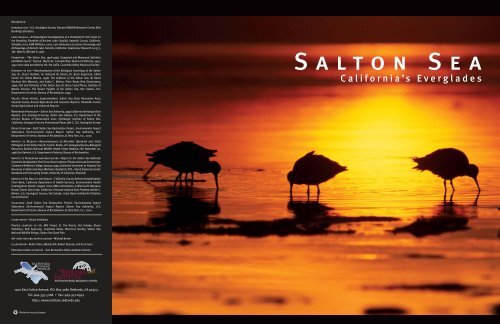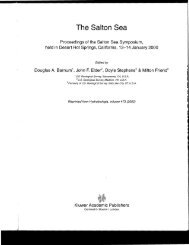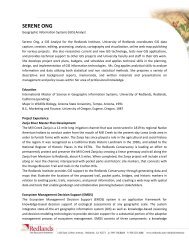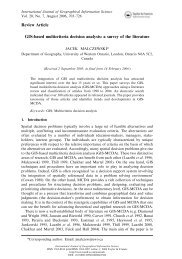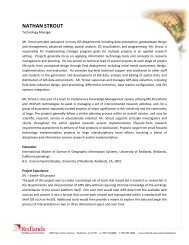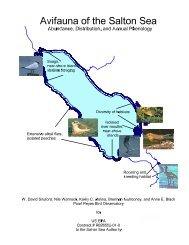Salton Sea Booklet - Spatial Programs at the University of Redlands
Salton Sea Booklet - Spatial Programs at the University of Redlands
Salton Sea Booklet - Spatial Programs at the University of Redlands
You also want an ePaper? Increase the reach of your titles
YUMPU automatically turns print PDFs into web optimized ePapers that Google loves.
References:<br />
Introduction—U.S. Geological Survey, P<strong>at</strong>uxent Wildlife Research Center, Bird<br />
Banding Labor<strong>at</strong>ory<br />
Lake Cahuilla—Archaeological Investig<strong>at</strong>ions <strong>at</strong> a Protohistoric Fish Camp on<br />
<strong>the</strong> Receding Shoreline <strong>of</strong> Ancient Lake Cahuilla, Imperial County, California.<br />
Schaefer, Jerry, ASM Affili<strong>at</strong>es, 2000; L<strong>at</strong>e Holocene Lacustrine Chronology and<br />
Archaeology <strong>of</strong> Ancient Lake Cahuilla, California. Qu<strong>at</strong>ernary Research 19:373-<br />
387. W<strong>at</strong>ers, Michael R.,1983<br />
Form<strong>at</strong>ion—'The <strong>Salton</strong> <strong>Sea</strong>, 1906-1996, Computed and Measured Salinities<br />
and W<strong>at</strong>er Levels'. Tostrud , Merlin B., Colorado River Board <strong>of</strong> California, 1997;<br />
1997-2000 d<strong>at</strong>a provided by IID; P<strong>at</strong> Laflin, Coachella Valley Historical Society<br />
Diversity <strong>of</strong> Life—Reconnaissance <strong>of</strong> <strong>the</strong> Biological Limnology <strong>of</strong> <strong>the</strong> <strong>Salton</strong><br />
<strong>Sea</strong>, Dr. Stuart Hurlbert, Dr. Deborah M. Dexter, Dr. Boris Kuperman, SDSU<br />
Center For Inland W<strong>at</strong>ers, 1998; The Avifauna <strong>of</strong> <strong>the</strong> <strong>Salton</strong> <strong>Sea</strong>, W. David<br />
Shuford, Nils Warnock, and K<strong>at</strong>hy C. Molina, Point Reyes Bird Observ<strong>at</strong>ory,<br />
1999; Fish and Fisheries <strong>of</strong> <strong>the</strong> <strong>Salton</strong> <strong>Sea</strong>, Dr. Barry Costa-Pierce, Institute <strong>of</strong><br />
Marine Science; The Desert Pupfish <strong>of</strong> <strong>the</strong> <strong>Salton</strong> <strong>Sea</strong>, Ron Sutton, U.S.<br />
Department <strong>of</strong> Interior, Bureau <strong>of</strong> Reclam<strong>at</strong>ion, 1999<br />
Values—Steve Horvitz, Superintendent, <strong>Salton</strong> <strong>Sea</strong> St<strong>at</strong>e Recre<strong>at</strong>ion Area;<br />
Imperial County Annual Agricultural and Livestock Reports; Riverside County<br />
Annual Agricultural and Livestock Reports<br />
W<strong>at</strong>ershed Hydrology—<strong>Salton</strong> <strong>Sea</strong> Authority, 1999 California Hydrologic D<strong>at</strong>a<br />
Reports, U.S. Geological Survey; <strong>Salton</strong> <strong>Sea</strong> Inflows, U.S. Department <strong>of</strong> <strong>the</strong><br />
Interior, Bureau <strong>of</strong> Reclam<strong>at</strong>ion 2001; Hydrologic regimen <strong>of</strong> <strong>Salton</strong> <strong>Sea</strong>,<br />
California, Geological Survey Pr<strong>of</strong>essional Paper 486-C, U.S. Geological Survey<br />
Reduced Inflow—Draft <strong>Salton</strong> <strong>Sea</strong> Restor<strong>at</strong>ion Project: Environmental Impact<br />
St<strong>at</strong>ement, Environmental Impact Report. <strong>Salton</strong> <strong>Sea</strong> Authority, U.S.<br />
Department <strong>of</strong> Interior, Bureau <strong>of</strong> Reclam<strong>at</strong>ion, & Tetra Tech, Inc., 2000<br />
Impacts to Wildlife—Reconnaissance <strong>of</strong> Microbial (Bacterial and Viral)<br />
P<strong>at</strong>hogens in <strong>the</strong> <strong>Salton</strong> <strong>Sea</strong>, Dr. Tonie E. Rocke, U.S. Geological Survey, Biological<br />
Resources Division N<strong>at</strong>ional Wildlife Health Center Madison, WI, November 30,<br />
1998; Jim Setmire, U.S. Department <strong>of</strong> Interior, Bureau <strong>of</strong> Reclam<strong>at</strong>ion<br />
Impacts to Recre<strong>at</strong>ion and Agriculture—Report to <strong>the</strong> <strong>Salton</strong> <strong>Sea</strong> Authority<br />
Economic Development Task Force, Rose Institute <strong>of</strong> St<strong>at</strong>e and Local Government,<br />
Claremont McKenna College, January 1999; Estim<strong>at</strong>ed Increment to Property Tax<br />
Revenues in <strong>Salton</strong> <strong>Sea</strong> Area, Michael J. Bazdarich, PhD., Inland Empire Economic<br />
D<strong>at</strong>abank and Forecasting Center, <strong>University</strong> <strong>of</strong> California, Riverside<br />
Impacts to Air Quality and Health—California County Asthma Hospitaliz<strong>at</strong>ion<br />
Chart Book, California Department <strong>of</strong> Health Services, Environmental Health<br />
Investig<strong>at</strong>ions Branch, August 2000; PM10 Inform<strong>at</strong>ion, California Air Resource<br />
Board; Owens (Dry) Lake, California: A Human-Induced Dust Problem, Marith C.<br />
Reheis, U.S. Geological Survey; Ted Schade, Gre<strong>at</strong> Basin Unified Air Pollution<br />
Control District<br />
Solutions—Draft <strong>Salton</strong> <strong>Sea</strong> Restor<strong>at</strong>ion Project: Environmental Impact<br />
St<strong>at</strong>ement, Environmental Impact Report, <strong>Salton</strong> <strong>Sea</strong> Authority, U.S.<br />
Department <strong>of</strong> Interior, Bureau <strong>of</strong> Reclam<strong>at</strong>ion, & Tetra Tech, Inc., 2000<br />
<strong>Salton</strong> <strong>Sea</strong><br />
California’s Everglades<br />
Cover photo—Shuzo Yoshihara<br />
Photos courtesy <strong>of</strong>—Dr. Milt Friend, Dr. Tim Krantz, Ted Schade, Shuzo<br />
Yoshihara, Bob Sporrong, Coachella Valley Historical Society, <strong>Salton</strong> <strong>Sea</strong><br />
N<strong>at</strong>ional Wildlife Refuge, <strong>Salton</strong> <strong>Sea</strong> St<strong>at</strong>e Park<br />
Art direction and graphic design—Michael Brown<br />
Illustr<strong>at</strong>ion—Robert Rose, Wendy Atil, Robert Rusnak, and Scott Goto<br />
Printing funded in part by—San Bernardino Valley Audubon Society<br />
1200 East Colton Avenue, P.O. Box 3080 <strong>Redlands</strong>, CA 92373<br />
Tel: 909-335-5268 • Fax: 909-307-6952<br />
http://www.institute.redlands.edu<br />
Printed on recycled paper
I NTRODUCTION<br />
2<br />
The <strong>Salton</strong> <strong>Sea</strong> may be likened to California’s “Everglades.” As a birdw<strong>at</strong>cher, this is <strong>the</strong> only place in<br />
California where one can see such variety and abundance <strong>of</strong> herons, egrets, ibises and woodstorks—species also characterizing<br />
Florida’s Everglades, but <strong>the</strong> <strong>Salton</strong> <strong>Sea</strong> <strong>of</strong>fers even gre<strong>at</strong>er species diversity! More than two thirds <strong>of</strong> all species <strong>of</strong> birds in <strong>the</strong><br />
continental United St<strong>at</strong>es have been recorded here! With <strong>the</strong> loss <strong>of</strong> over 90% <strong>of</strong> wetlands in <strong>the</strong> st<strong>at</strong>e, <strong>the</strong> <strong>Salton</strong> <strong>Sea</strong> is a critical<br />
stopover for millions <strong>of</strong> migr<strong>at</strong>ing birds. For many species, sustaining <strong>the</strong> <strong>Sea</strong> is a m<strong>at</strong>ter <strong>of</strong> life or de<strong>at</strong>h. The <strong>Sea</strong> supports<br />
45 % <strong>of</strong> <strong>the</strong> entire U.S. popul<strong>at</strong>ion <strong>of</strong> <strong>the</strong> thre<strong>at</strong>ened Yuma clapper rail, 80% <strong>of</strong> <strong>the</strong> American white pelican, and 90% <strong>of</strong> <strong>the</strong> continental<br />
popul<strong>at</strong>ion <strong>of</strong> <strong>the</strong> eared grebe. With an estim<strong>at</strong>ed standing crop <strong>of</strong> over 200 million fish, <strong>the</strong> <strong>Salton</strong> <strong>Sea</strong> also supports<br />
one <strong>of</strong> <strong>the</strong> most productive sport fisheries in <strong>the</strong> world, and is renowned for its unrivaled c<strong>at</strong>ch r<strong>at</strong>es.<br />
California’s largest lake <strong>at</strong> 367 square miles, <strong>the</strong> <strong>Salton</strong> <strong>Sea</strong> is loc<strong>at</strong>ed in sou<strong>the</strong>astern California just 30 miles north <strong>of</strong> <strong>the</strong> U.S.-<br />
Mexico border. The <strong>Salton</strong> <strong>Sea</strong> <strong>of</strong>fers many recre<strong>at</strong>ional opportunities including fishing, bird w<strong>at</strong>ching, bo<strong>at</strong>ing, skiing, camping,<br />
hiking, and photography. These resources are imminently thre<strong>at</strong>ened by rising salinity, excessive nutrient run-<strong>of</strong>f from agriculture,<br />
and proposed w<strong>at</strong>er transfers. Economic solutions exist for controlling salinity and nutrient loading, but <strong>the</strong>se altern<strong>at</strong>ives<br />
will not work if inflows to <strong>the</strong> <strong>Sea</strong> are gre<strong>at</strong>ly reduced. Among <strong>the</strong> immedi<strong>at</strong>e concerns, rising salinity, if continued unchecked,<br />
will ultim<strong>at</strong>ely make <strong>the</strong> <strong>Sea</strong> unable to support its fishery and, <strong>the</strong>refore, fish-e<strong>at</strong>ing birds. Without a plentiful food supply <strong>at</strong> <strong>the</strong><br />
<strong>Salton</strong> <strong>Sea</strong>, many species such as eared grebes may not be able to make <strong>the</strong>ir return migr<strong>at</strong>ions across <strong>the</strong> desert. In <strong>the</strong> context<br />
<strong>of</strong> massive habit<strong>at</strong> loss elsewhere, and <strong>the</strong> continuing escal<strong>at</strong>ion in demand for w<strong>at</strong>er resources, <strong>the</strong> future <strong>of</strong> <strong>the</strong> <strong>Salton</strong> <strong>Sea</strong> is<br />
<strong>of</strong> vital importance for both wildlife and growing human popul<strong>at</strong>ions.<br />
More than 400 species <strong>of</strong><br />
birds found <strong>at</strong> <strong>the</strong> <strong>Sea</strong><br />
•<br />
The <strong>Sea</strong> supports millions <strong>of</strong><br />
birds during migr<strong>at</strong>ion—<br />
two-thirds <strong>of</strong> all species in<br />
continental United St<strong>at</strong>es<br />
<strong>Salton</strong> <strong>Sea</strong><br />
Intern<strong>at</strong>ional Avian Airport<br />
The d<strong>at</strong>a on <strong>the</strong> globe represents 20,000 leg bands <strong>of</strong> birds banded <strong>at</strong> <strong>the</strong><br />
sea and recovered across North and South America. Many birds apparently<br />
migr<strong>at</strong>e to breeding grounds on <strong>the</strong> nor<strong>the</strong>rn Gre<strong>at</strong> Plains, <strong>the</strong>n fly to <strong>the</strong><br />
Gulf <strong>of</strong> Mexico or back during <strong>the</strong> next season. W<strong>at</strong>erfowl and snow geese<br />
fly to <strong>the</strong> North Slope and Arctic Islands—with 85 recoveries from Nunavut<br />
in nor<strong>the</strong>rn Canada, 175 bands from Alaska, and 22 from nor<strong>the</strong>rn Russia!<br />
Thirty bands were returned from Mexico and Central America, one from<br />
Peru, five from <strong>the</strong> Caribbean, and three from wayward birds in Hawaii!<br />
Number <strong>of</strong> Banded Birds<br />
Scientists <strong>at</strong> <strong>the</strong> <strong>University</strong> <strong>of</strong> <strong>Redlands</strong><br />
expected <strong>the</strong> bird banding d<strong>at</strong>a to illustr<strong>at</strong>e<br />
<strong>the</strong> importance <strong>of</strong> <strong>the</strong> <strong>Salton</strong> <strong>Sea</strong> for birds<br />
migr<strong>at</strong>ing along <strong>the</strong> Pacific Flyway.<br />
However, <strong>the</strong> d<strong>at</strong>a clearly show a much<br />
broader significance <strong>of</strong> <strong>the</strong> <strong>Sea</strong> for<br />
migr<strong>at</strong>ing birds across all <strong>of</strong><br />
Western North America.
FORMATION<br />
Ancient Gulf and Lake Cahuilla<br />
The Lower Colorado River has changed its course many times in <strong>the</strong> past. Mud and sand cut from <strong>the</strong> Grand Canyon over several<br />
million years filled <strong>the</strong> lower reaches <strong>of</strong> <strong>the</strong> Colorado River. At <strong>the</strong> end <strong>of</strong> its journey to <strong>the</strong> Gulf <strong>of</strong> California, <strong>the</strong> river<br />
fanned out and deposited sediment, building a massive delta. Continued sediment deposits established a n<strong>at</strong>ural dam—or<br />
berm—across <strong>the</strong> Gulf, isol<strong>at</strong>ing <strong>the</strong> arm <strong>of</strong> <strong>the</strong> sea to <strong>the</strong> north as a new lake, ancient Lake Cahuilla. The isol<strong>at</strong>ed lake took<br />
more than 50 years to evapor<strong>at</strong>e in <strong>the</strong> arid desert clim<strong>at</strong>e, leaving a barren depression 278 feet below sea level—<strong>the</strong> <strong>Salton</strong><br />
Basin. For several million years, <strong>the</strong> Colorado River changed course, driven by sediment deposits and periodic floods, sometimes<br />
flowing south to <strong>the</strong> Gulf, and sometimes to <strong>the</strong> north, filling <strong>the</strong> <strong>Salton</strong> Basin to its brim before spilling back to <strong>the</strong><br />
Gulf <strong>of</strong> California forty miles south <strong>of</strong> <strong>the</strong> border in Mexico.<br />
The Ancient Gulf<br />
Millions <strong>of</strong> years ago,<br />
<strong>the</strong> Gulf <strong>of</strong> California<br />
extended past present<br />
day Indio.<br />
Form<strong>at</strong>ion <strong>of</strong> <strong>the</strong> <strong>Salton</strong> <strong>Sea</strong><br />
In <strong>the</strong> first few years <strong>of</strong> <strong>the</strong> 1900s, <strong>the</strong> Imperial Valley blossomed into fertile farmland courtesy <strong>of</strong> <strong>the</strong> Colorado River. But <strong>the</strong><br />
Colorado proved a fickle benefactor, first filling <strong>the</strong> main canal feeding <strong>the</strong> valley with silt, <strong>the</strong>n breaking through a new channel<br />
constructed to relieve <strong>the</strong> shortage. The flood <strong>of</strong> 1905 widened <strong>the</strong> channel to more<br />
than a half-mile, all th<strong>at</strong> was necessary for <strong>the</strong> entire Colorado River to come “Far from being an<br />
rushing through, spreading over an area ten miles wide before<br />
‘accidental lake,’ it was<br />
flowing down into <strong>the</strong> basin and forming <strong>the</strong> <strong>Salton</strong> <strong>Sea</strong>. The<br />
floods in June <strong>of</strong> 1906 poured so much w<strong>at</strong>er into <strong>the</strong> human intervention...”<br />
basin th<strong>at</strong> <strong>the</strong> <strong>Salton</strong> <strong>Sea</strong> rose as much as seven inches<br />
a day, covering upwards <strong>of</strong> 400 square miles. The breach was finally<br />
filled in 1907. Far from being an “accidental lake,” it was human<br />
intervention th<strong>at</strong> prevented <strong>the</strong> next stand <strong>of</strong> Lake Cahuilla.<br />
Today, agricultural run<strong>of</strong>f largely maintains <strong>the</strong> <strong>Sea</strong>.<br />
4<br />
Form<strong>at</strong>ion <strong>of</strong><br />
<strong>the</strong> Delta<br />
The w<strong>at</strong>ers <strong>of</strong> <strong>the</strong><br />
Colorado slowed as<br />
it entered <strong>the</strong> Gulf,<br />
depositing millions<br />
<strong>of</strong> tons <strong>of</strong> sediment<br />
collected during its<br />
journey, cre<strong>at</strong>ing a<br />
massive delta.<br />
Gulf Flow<br />
Now separ<strong>at</strong>ed from <strong>the</strong><br />
Gulf, <strong>the</strong> fickle flows <strong>of</strong> <strong>the</strong><br />
Colorado River occasionally<br />
drained directly into <strong>the</strong><br />
Gulf, drying <strong>the</strong> <strong>Salton</strong> Basin.<br />
Periodic Inund<strong>at</strong>ion<br />
Depending on sediment<br />
deposits and flooding, <strong>the</strong><br />
river would change course,<br />
filling <strong>the</strong> basin to <strong>the</strong> north.<br />
Over Flow<br />
At times, <strong>the</strong> river would flow to <strong>the</strong><br />
Gulf via <strong>the</strong> <strong>Salton</strong> Basin. This<br />
occurred when <strong>the</strong> lake filled to<br />
<strong>the</strong> height <strong>of</strong> <strong>the</strong> deltaic berm, overflowing<br />
into <strong>the</strong> Gulf.<br />
Periodicity<br />
During <strong>the</strong> last 1,300 years, w<strong>at</strong>er filled <strong>the</strong> <strong>Salton</strong> Basin<br />
more <strong>of</strong>ten than not. A number <strong>of</strong> smaller lakes existed<br />
after 1600, including nine during <strong>the</strong> 1800’s. Shoreline<br />
evidence <strong>of</strong> lake deposits and archaeological sites document<br />
<strong>the</strong> history <strong>of</strong> Lake Cahuilla.
DIVERSITY OF LIFE<br />
6<br />
The nutrient-rich agricultural drainage th<strong>at</strong> sustains <strong>the</strong> <strong>Salton</strong> <strong>Sea</strong> also supports an incredible diversity <strong>of</strong> life.<br />
More than 400 species <strong>of</strong> invertebr<strong>at</strong>es, mostly plankton, have been identified in <strong>the</strong> <strong>Sea</strong>. These provide <strong>the</strong> food base supporting<br />
<strong>the</strong> <strong>Sea</strong>’s productive fishery—with an estim<strong>at</strong>ed 200 million fish, one <strong>of</strong> <strong>the</strong> most productive fisheries in <strong>the</strong><br />
world. The fish, in turn, are consumed by fish-e<strong>at</strong>ing birds. The <strong>Salton</strong> <strong>Sea</strong> supports over 80% <strong>of</strong> American white<br />
pelicans, <strong>the</strong> only North American inland breeding site for brown pelicans, and more than 90% <strong>of</strong> <strong>the</strong> North<br />
American popul<strong>at</strong>ion <strong>of</strong> eared grebes. From <strong>the</strong> subtropical clim<strong>at</strong>e <strong>of</strong> <strong>the</strong> <strong>Sea</strong> itself to <strong>the</strong> alpine summits<br />
<strong>of</strong> Mt. San Gorgonio and Mt. San Jacinto, <strong>the</strong> diversity <strong>of</strong> topography and life<br />
zones, toge<strong>the</strong>r with a diversity <strong>of</strong> wetland habit<strong>at</strong>s, conspire to make <strong>the</strong> <strong>Salton</strong><br />
<strong>Sea</strong> one <strong>of</strong> <strong>the</strong> most diverse bird hot spots in <strong>the</strong> world. With more than 400<br />
species—two-thirds <strong>of</strong> all birds in <strong>the</strong> continental United St<strong>at</strong>es, <strong>the</strong> <strong>Salton</strong><br />
<strong>Sea</strong> supports one <strong>of</strong> <strong>the</strong> richest avifaunas in <strong>the</strong> world.<br />
Critters<br />
The <strong>Salton</strong> <strong>Sea</strong> is teeming with life. Plankton are plentiful<br />
and surprisingly diverse as well. Researchers<br />
have identified more than 400 species <strong>of</strong><br />
microorganisms in <strong>the</strong> <strong>Salton</strong> <strong>Sea</strong>, several <strong>of</strong><br />
<strong>the</strong>m new to science. These microorganisms<br />
are e<strong>at</strong>en by tiny brine shrimp and in<br />
turn are e<strong>at</strong>en by pileworms,<br />
<strong>the</strong> key food source for<br />
fish and birds.<br />
Agricultural Fields<br />
Unfarmed fields, harvested and flooded fields<br />
provide habit<strong>at</strong> for numerous wintering<br />
birds, from nor<strong>the</strong>rn harriers and shorteared<br />
owls to western meadowlarks.<br />
As many as 30,000 snow geese carpet<br />
<strong>the</strong> fields during winter months.<br />
Subtropical Birds<br />
Braving <strong>the</strong> summer he<strong>at</strong>, <strong>the</strong> <strong>Salton</strong> <strong>Sea</strong> is<br />
renowned among birdw<strong>at</strong>chers and ornithologists<br />
for its unusual subtropical species, such<br />
as magnificent frig<strong>at</strong>ebirds, bluefooted<br />
boobies, yellow-footed<br />
gulls, and wood storks.<br />
Fish<br />
Diverse aqu<strong>at</strong>ic habit<strong>at</strong>s <strong>at</strong> <strong>the</strong> <strong>Salton</strong> <strong>Sea</strong> support a thriving fish<br />
popul<strong>at</strong>ion. Carp and c<strong>at</strong>fish use freshw<strong>at</strong>er areas <strong>of</strong> <strong>the</strong> New and<br />
Alamo Rivers. Shoreline areas are important habit<strong>at</strong> for spawning<br />
tilapia and desert pupfish. The open w<strong>at</strong>ers provide habit<strong>at</strong> for<br />
tilapia, croaker, sargo, and orange-mouth corvina. Fishermen frequently<br />
c<strong>at</strong>ch corvina weighing over 20 pounds, and a day with<br />
over 100 tilapia is not unusual.<br />
Mullet Island<br />
Mullet Island provides refuge for thousands <strong>of</strong> ground-nesting birds. Separ<strong>at</strong>ed from <strong>the</strong> shore<br />
by only seven feet <strong>of</strong> w<strong>at</strong>er, <strong>the</strong> island would be bridged to <strong>the</strong> mainland with only modest reductions<br />
<strong>of</strong> inflow to <strong>the</strong> <strong>Sea</strong>, exposing <strong>the</strong> nesting site to pred<strong>at</strong>ors, such as c<strong>at</strong>s and coyotes.<br />
Shoreline Habit<strong>at</strong>s<br />
The shoreline varies from mudfl<strong>at</strong>s to barnacle beaches.<br />
Breakw<strong>at</strong>ers, jetties, marinas, pilings, and embankments provide<br />
roosts and forage sites for pelicans, shorebirds, gulls,<br />
and terns, and nest sites for tern colonies.<br />
Hundreds <strong>of</strong> thousands <strong>of</strong> shorebirds<br />
<strong>of</strong> 44 different species use <strong>the</strong> <strong>Sea</strong><br />
during migr<strong>at</strong>ion.<br />
A Keystone Species: Pileworms<br />
A keystone species, if removed from <strong>the</strong> ecosystem, would result in <strong>the</strong> collapse <strong>of</strong> many o<strong>the</strong>r<br />
species. The pileworm is <strong>the</strong> keystone species in <strong>the</strong> <strong>Salton</strong> <strong>Sea</strong> ecosystem, providing <strong>the</strong><br />
critical link between <strong>the</strong> organic m<strong>at</strong>erial th<strong>at</strong> settles on <strong>the</strong> sea floor and <strong>the</strong> higher organisms,<br />
such as fish and birds.<br />
Pupfish—Desert Survivors<br />
The desert pupfish is <strong>the</strong> only n<strong>at</strong>ive fish in <strong>the</strong> <strong>Sea</strong>. Thriving during Lake Cahuilla episodes,<br />
it retre<strong>at</strong>ed up slow-moving creeks in <strong>the</strong> <strong>Salton</strong> Basin during dry periods. Today <strong>the</strong> pupfish<br />
occur in shoreline pools and in <strong>the</strong> agricultural drains. They were listed as an endangered species<br />
in 1980 (St<strong>at</strong>e) and 1986 (Federal).
VALUES<br />
8<br />
In <strong>the</strong> 20th century, life <strong>at</strong> <strong>the</strong> <strong>Salton</strong> <strong>Sea</strong> saw many changes. A booming agricultural industry, supported<br />
by Colorado River w<strong>at</strong>er and a transcontinental railhead, transformed <strong>the</strong> barren desert. The ancient lake, once a bountiful<br />
Agriculture<br />
Winter Breadbasket <strong>of</strong> <strong>the</strong> United St<strong>at</strong>es<br />
Today, Imperial Valley’s agricultural lands include over<br />
572,286 acres; farmland in Coachella Valley covers about<br />
56,600 acres. Control <strong>of</strong> <strong>the</strong> Colorado River and construction<br />
<strong>of</strong> <strong>the</strong> All-American and Coachella Canals made<br />
expansion <strong>of</strong> agricultural land possible, cre<strong>at</strong>ing a billiondollar<br />
industry in <strong>the</strong> Basin. A frost-free clim<strong>at</strong>e with temper<strong>at</strong>e<br />
seasons and dry summers allows for year-round<br />
crops, making <strong>the</strong> Valleys farmlands some <strong>of</strong> <strong>the</strong> most<br />
productive in <strong>the</strong> world. While most farming in <strong>the</strong><br />
Midwestern corn belt <strong>of</strong> <strong>the</strong> United St<strong>at</strong>es comes to a halt<br />
during <strong>the</strong> winter, <strong>the</strong> <strong>Salton</strong> Basin continues to supply<br />
<strong>the</strong> n<strong>at</strong>ion with plentiful fruits and vegetables.<br />
resource for <strong>the</strong> n<strong>at</strong>ive peoples, was reborn as <strong>the</strong><br />
<strong>Salton</strong> <strong>Sea</strong>, cre<strong>at</strong>ed by n<strong>at</strong>ural disaster “...<strong>the</strong> <strong>Sea</strong> is still a<br />
and sustained by irrig<strong>at</strong>ion run<strong>of</strong>f.<br />
bountiful oasis...”<br />
Today, <strong>the</strong> <strong>Sea</strong> is still a bountiful<br />
oasis, supporting a diverse ecology and one <strong>of</strong> <strong>the</strong> most productive<br />
fisheries in <strong>the</strong> world.<br />
Corn Fields<br />
Mild winter temper<strong>at</strong>ures allow<br />
four-season crop production.<br />
Recre<strong>at</strong>ional Hot Spot<br />
The <strong>Salton</strong> <strong>Sea</strong> is within a 90-minute drive <strong>of</strong> 20 million<br />
people in Sou<strong>the</strong>rn and Baja California. In <strong>the</strong> past four<br />
years, visit<strong>at</strong>ion <strong>at</strong> <strong>the</strong> <strong>Salton</strong> <strong>Sea</strong> has<br />
increased to an average <strong>of</strong> 250,000 a year.<br />
New fishing jetties, a bo<strong>at</strong> launch, harbor facilities, upgraded campgrounds, day<br />
use areas, more parking lots, expanded trails and visitor centers are planned. St<strong>at</strong>e<br />
Park visitor centers <strong>of</strong>fer educ<strong>at</strong>ional seminars, interpretive programs, kayak, and<br />
jet bo<strong>at</strong> trips. The Sonny Bono N<strong>at</strong>ional Wildlife Refuge <strong>of</strong>fers ano<strong>the</strong>r visitor center,<br />
trails, and some <strong>of</strong> <strong>the</strong> best birding opportunities <strong>at</strong> <strong>the</strong> <strong>Sea</strong>. Several priv<strong>at</strong>e<br />
and public facilities are<br />
available for w<strong>at</strong>erfowl<br />
hunting, including managed<br />
wetland habit<strong>at</strong>s.<br />
Recre<strong>at</strong>ional Facilities<br />
The North Shore Yacht Club and<br />
o<strong>the</strong>r resorts were a popular get<br />
away for many famous guests, such<br />
as Frank Sin<strong>at</strong>ra and Sonny Bono.<br />
<strong>Salton</strong> <strong>Sea</strong> Santa<br />
The "Santa Ski-In" was started<br />
by Helen Burns, a property<br />
owner <strong>at</strong> <strong>Salton</strong> <strong>Sea</strong> Beach,<br />
about 1960. Floyd Hollenger,<br />
seen here as ‘Santa’, has been<br />
entertaining children <strong>at</strong> <strong>the</strong> sea<br />
for over 20 years.<br />
Geese<br />
Agricultural fields provide habit<strong>at</strong><br />
for geese, mountain plovers, whitefaced<br />
ibis, and many o<strong>the</strong>r birds.<br />
Birdw<strong>at</strong>ching<br />
Bird w<strong>at</strong>ching is an increasingly<br />
popular "sport" around<br />
<strong>the</strong> <strong>Sea</strong>, <strong>at</strong>tracting thousands<br />
<strong>of</strong> visitors each year.<br />
Bo<strong>at</strong>ing<br />
Because its salt content causes<br />
vessels to be more buoyant,<br />
bo<strong>at</strong>ing on <strong>the</strong> <strong>Sea</strong> is known as<br />
<strong>the</strong> fastest in <strong>the</strong> n<strong>at</strong>ion—hosting<br />
many w<strong>at</strong>er speed records.
WATERSHED HYDROLOGY<br />
10<br />
<strong>Salton</strong> Basin Hydrology<br />
All w<strong>at</strong>er bodies have a w<strong>at</strong>ershed—<strong>the</strong> area where n<strong>at</strong>ural precipit<strong>at</strong>ion falls<br />
before flowing to <strong>the</strong> lake or river. Unlike many w<strong>at</strong>ersheds, <strong>the</strong> <strong>Salton</strong><br />
Basin has no outlet. The <strong>Sea</strong> lies <strong>at</strong> <strong>the</strong> bottom <strong>of</strong> a 7,851 sq. mi.<br />
(20,333 sq. km) w<strong>at</strong>ershed collecting all drainage within<br />
this closed basin. Over 90% <strong>of</strong> all w<strong>at</strong>er entering <strong>the</strong><br />
<strong>Sea</strong> results from agricultural run<strong>of</strong>f, with <strong>the</strong> remaining<br />
coming from n<strong>at</strong>ural precipit<strong>at</strong>ion, ground<br />
w<strong>at</strong>er, or urban use. Once diverted to <strong>the</strong> <strong>Salton</strong><br />
Basin, urban and agricultural practices concentr<strong>at</strong>e<br />
salts and minerals already in <strong>the</strong><br />
Colorado River w<strong>at</strong>er. Agriculture and urban<br />
uses in <strong>the</strong> w<strong>at</strong>ershed also add more nutrients,<br />
salts, and chemicals. Several million<br />
tons <strong>of</strong> salt are added to <strong>the</strong> <strong>Salton</strong> <strong>Sea</strong><br />
every year. An enormous amount <strong>of</strong> w<strong>at</strong>er<br />
1.36 million acre-feet, over 15% <strong>of</strong> <strong>the</strong> total<br />
volume <strong>of</strong> <strong>the</strong> <strong>Sea</strong> evapor<strong>at</strong>es each year, leaving<br />
behind millions <strong>of</strong> tons <strong>of</strong> salts, minerals,<br />
and nutrients. Salinity has increased from <strong>the</strong> very<br />
low levels found in <strong>the</strong> Colorado River to 25% more<br />
than ocean w<strong>at</strong>er.<br />
Evapor<strong>at</strong>ion<br />
The large surface area <strong>of</strong> <strong>the</strong> <strong>Sea</strong> and <strong>the</strong><br />
desert environment cause a large amount<br />
<strong>of</strong> w<strong>at</strong>er to evapor<strong>at</strong>e. Evapor<strong>at</strong>ion concentr<strong>at</strong>es<br />
various chemicals in <strong>the</strong> <strong>Salton</strong> <strong>Sea</strong>,<br />
including salts.<br />
Agriculture Run<strong>of</strong>f<br />
Irrig<strong>at</strong>ion w<strong>at</strong>er collects salts and o<strong>the</strong>r minerals<br />
n<strong>at</strong>urally occurring in soils. Fertilizers and pesticides<br />
can also accumul<strong>at</strong>e in drain w<strong>at</strong>er. Pesticide<br />
levels in <strong>the</strong> <strong>Sea</strong>, however, are currently<br />
lower than Federal drinking w<strong>at</strong>er standards.<br />
Colorado River W<strong>at</strong>er<br />
The n<strong>at</strong>ural run<strong>of</strong>f feeding <strong>the</strong> Colorado River<br />
accumul<strong>at</strong>es various sediments and minerals.<br />
Some n<strong>at</strong>urally occurring elements, like salts<br />
and selenium, become concentr<strong>at</strong>ed as <strong>the</strong><br />
river progresses.<br />
In-Basin Precipit<strong>at</strong>ion<br />
With an average <strong>of</strong> 2.5 inches<br />
<strong>of</strong> rain per year, only 3% <strong>of</strong> <strong>the</strong><br />
w<strong>at</strong>er entering <strong>the</strong> sea comes<br />
from n<strong>at</strong>ural precipit<strong>at</strong>ion.<br />
Groundw<strong>at</strong>er<br />
Rainfall<br />
O<strong>the</strong>r Sources<br />
Agriculture<br />
Drains<br />
Whitew<strong>at</strong>er<br />
River<br />
Alamo River<br />
Groundw<strong>at</strong>er<br />
Freshw<strong>at</strong>er aquifers<br />
under <strong>the</strong> <strong>Salton</strong> Basin<br />
are <strong>the</strong> smallest contributors <strong>of</strong><br />
w<strong>at</strong>er entering <strong>the</strong> <strong>Sea</strong>. Less than<br />
100,000 acre-feet enter <strong>the</strong> <strong>Sea</strong> from<br />
groundw<strong>at</strong>er each year.<br />
Urban Run<strong>of</strong>f<br />
A rel<strong>at</strong>ively small portion <strong>of</strong> w<strong>at</strong>er entering<br />
<strong>the</strong> sea results from urban uses.<br />
Much <strong>of</strong> <strong>the</strong> urban pollutants are<br />
sequestered in riparian veget<strong>at</strong>ion and<br />
sediments before <strong>the</strong>y reach <strong>the</strong> <strong>Sea</strong>.<br />
New River
REDUCED INFLOW<br />
Proposed w<strong>at</strong>er transfers from <strong>the</strong> Imperial<br />
Irrig<strong>at</strong>ion District (IID) to San Diego may result in reductions <strong>of</strong><br />
inflow to <strong>the</strong> <strong>Salton</strong> <strong>Sea</strong>. Presently, <strong>the</strong> proposed w<strong>at</strong>er transfer,<br />
toge<strong>the</strong>r with o<strong>the</strong>r actions listed below, may result in reductions<br />
<strong>of</strong> inflow by as much as 500,000 acre-feet <strong>of</strong> w<strong>at</strong>er from <strong>the</strong> 1.36<br />
million acre-feet (maf) th<strong>at</strong> sustain <strong>the</strong> <strong>Sea</strong> today. The <strong>Salton</strong> <strong>Sea</strong><br />
D<strong>at</strong>abase Program modeled <strong>the</strong>se reductions and <strong>the</strong>ir resulting<br />
drawdowns using b<strong>at</strong>hymetric d<strong>at</strong>a from <strong>the</strong> U.S. Bureau <strong>of</strong><br />
Reclam<strong>at</strong>ion and inflow d<strong>at</strong>a from <strong>the</strong> IID. The results <strong>of</strong> reduced<br />
inflows from <strong>the</strong> transfer (300 kaf (thousand acre-feet)) and <strong>the</strong><br />
cumul<strong>at</strong>ive reduction <strong>of</strong> 500 kaf from all causes were modeled.<br />
A Broad Shallow Lake<br />
35 miles long, but only 51 feet deep—equivalent to 300 feet long<br />
or a football field, yet only one inch deep—<strong>the</strong> shallow<br />
n<strong>at</strong>ure <strong>of</strong> <strong>the</strong> <strong>Sea</strong> renders it very sensitive to<br />
even slight changes <strong>of</strong> inflow.<br />
12<br />
Potential Causes <strong>of</strong> Reduced Inflow<br />
Transfers (300 kaf)<br />
Proposed transfer <strong>of</strong> agricultural w<strong>at</strong>er from Imperial Valley<br />
to San Diego and o<strong>the</strong>r urban use.<br />
Mexicali wastew<strong>at</strong>er reclam<strong>at</strong>ion (65 kaf)<br />
Mexicali may build a tre<strong>at</strong>ment plant and<br />
reclaim some <strong>of</strong> <strong>the</strong>ir w<strong>at</strong>er.<br />
Salinity control (110 kaf)<br />
Salinity control measures, such as evapor<strong>at</strong>ion<br />
ponds, will take w<strong>at</strong>er from <strong>the</strong> sea.<br />
Canal lining (20 kaf)<br />
Lining <strong>of</strong> Coachella and All-<br />
American canals will conserve<br />
w<strong>at</strong>er but reduce<br />
<strong>the</strong> amount going into<br />
ground w<strong>at</strong>er.<br />
The <strong>Salton</strong> <strong>Sea</strong> With<br />
Reduced Inflows<br />
A reduction <strong>of</strong> inflow by<br />
300,000 acre-feet as a result <strong>of</strong><br />
proposed w<strong>at</strong>er transfers would<br />
lower <strong>the</strong> lake by 16 feet to 243 feet<br />
below sea level, exposing 42,633 acres (67<br />
square miles) <strong>of</strong> land.<br />
A reduction <strong>of</strong> inflow by 500,000 acre-feet from all causes would lower <strong>the</strong><br />
lake by 26 feet (more than half <strong>of</strong> total depth) to 253 feet below sea level, exposing 77,050<br />
acres (120 square miles) <strong>of</strong> land.
IMPACTS— WILDLIFE<br />
14<br />
Hotsprings and Spas<br />
Country Club<br />
Reduced Inflow Causes<br />
Rapid Increase in Salinity<br />
The contracting lake concentr<strong>at</strong>es a century <strong>of</strong> collected salt already in <strong>the</strong> <strong>Sea</strong>,<br />
while more salts continue to enter <strong>the</strong> <strong>Sea</strong> through agricultural run-<strong>of</strong>f.<br />
Duck Club<br />
Marina<br />
Campground<br />
Bird snags and roosts<br />
Fish Health<br />
Fish tolerances for salinity, temper<strong>at</strong>ure, and oxygen depletion vary gre<strong>at</strong>ly. The fish<br />
species living in <strong>the</strong> <strong>Sea</strong> are all adapted to high salinity, but no one knows wh<strong>at</strong> <strong>the</strong> limits<br />
<strong>of</strong> salt tolerance may be for any particular species. Salt is not a significant factor in <strong>the</strong><br />
fish kills occurring <strong>at</strong> <strong>the</strong> <strong>Sea</strong> today - which result from o<strong>the</strong>r environmental stresses.<br />
Disaster for Birds<br />
The loss <strong>of</strong> <strong>the</strong> fishery would spell disaster<br />
for many popul<strong>at</strong>ions <strong>of</strong> fish-e<strong>at</strong>ing<br />
birds. Unable to obtain sufficient food <strong>at</strong><br />
<strong>the</strong>ir wintering grounds, many birds,<br />
such as eared grebes, white pelicans,<br />
and cormorants would perish.<br />
Fishery Collapse<br />
Fish kills <strong>at</strong> <strong>the</strong> <strong>Sea</strong> today are <strong>the</strong> result <strong>of</strong> eutrophic<strong>at</strong>ion—too<br />
many nutrients cause algae blooms, and when <strong>the</strong> algae<br />
decomposes, toge<strong>the</strong>r with high summer temper<strong>at</strong>ures, <strong>the</strong> dissolved<br />
oxygen in <strong>the</strong> w<strong>at</strong>er plummets. Fish actually suffoc<strong>at</strong>e for<br />
lack <strong>of</strong> oxygen, not from pollution. The prospect <strong>of</strong> two hundred<br />
million fish dying within a<br />
few years from salinity<br />
toxicosis would make<br />
<strong>the</strong>se events today pale in<br />
comparison.<br />
B<br />
Wh<strong>at</strong>’s Th<strong>at</strong> Smell<br />
Changing physical, biological, and chemical processes produce a<br />
variety <strong>of</strong> odors: from <strong>the</strong> familiar rotten-egg stench <strong>of</strong> hydrogen<br />
sulfide (produced by bacteria when oxygen is low), to <strong>the</strong> crisp<br />
sea-salt smell <strong>of</strong> <strong>the</strong> saline w<strong>at</strong>ers. O<strong>the</strong>r influences in<br />
and around <strong>the</strong> <strong>Sea</strong> are agriculture, geo<strong>the</strong>rmal<br />
power plants, wetland habit<strong>at</strong>s, and even<br />
decaying fish. Conditions such as wind,<br />
he<strong>at</strong>, sunlight, and w<strong>at</strong>er quality <strong>of</strong><br />
inflow vary throughout <strong>the</strong> year,<br />
yielding <strong>the</strong> dynamic and unique<br />
smells characteristic <strong>of</strong> <strong>the</strong> <strong>Sea</strong>.<br />
Shoreline Drawdowns<br />
The areas most affected by lake drawdowns<br />
would be around <strong>the</strong> mouths <strong>of</strong> <strong>the</strong> rivers. The<br />
shoreline would withdraw by as much as three to<br />
five miles along <strong>the</strong> south shore, immedi<strong>at</strong>ely<br />
impacting existing wildlife habit<strong>at</strong> <strong>at</strong> <strong>the</strong> Sonny Bono<br />
<strong>Salton</strong> <strong>Sea</strong> N<strong>at</strong>ional Wildlife Refuge and <strong>the</strong> St<strong>at</strong>e<br />
Imperial Wildlife Area. Mullet Island—<strong>the</strong> only island in <strong>the</strong><br />
<strong>Sea</strong> providing a protected place for ground-nesting birds,<br />
such as brown pelicans—would be exposed to <strong>the</strong> mainland and<br />
pred<strong>at</strong>ors with a drop <strong>of</strong> only seven feet.<br />
A
IMPACTS— RECREATION<br />
& AGRICULTURE<br />
16<br />
Reduced Lake Elev<strong>at</strong>ions and a Dead <strong>Sea</strong><br />
Would Impact <strong>the</strong> Regional Economy<br />
Reduced Recre<strong>at</strong>ional<br />
Opportunities<br />
Impacts on recre<strong>at</strong>ion-oriented businesses,<br />
such as bo<strong>at</strong>ing, fishing, hunting<br />
and bird w<strong>at</strong>ching would be severe due to<br />
decline <strong>of</strong> facilities and loss <strong>of</strong> resources.<br />
Aral <strong>Sea</strong><br />
In central Asia, w<strong>at</strong>er transfers from <strong>the</strong> W<strong>at</strong>er Transfers Mean<br />
Aral <strong>Sea</strong> and its tributaries have cre<strong>at</strong>ed<br />
an environmental disaster th<strong>at</strong> could be<br />
Less Agriculture<br />
repe<strong>at</strong>ed <strong>at</strong> <strong>the</strong> <strong>Salton</strong> <strong>Sea</strong>.<br />
For every gallon <strong>of</strong> w<strong>at</strong>er transferred out <strong>of</strong> <strong>the</strong><br />
<strong>Salton</strong> Basin, <strong>the</strong>re is less w<strong>at</strong>er available for<br />
agriculture. Agricultural businesses can sustain<br />
<strong>the</strong>mselves by conserving w<strong>at</strong>er through conversion<br />
to less w<strong>at</strong>er-consumptive crops, better onfarm<br />
w<strong>at</strong>er management, or fallowing; all <strong>of</strong> which<br />
mean less w<strong>at</strong>er flowing into <strong>the</strong> <strong>Sea</strong>.<br />
Local Businesses<br />
Would Suffer<br />
A Rose Institute study in 1999 estim<strong>at</strong>ed th<strong>at</strong> a<br />
restored <strong>Sea</strong> would support a 6 billion dollar<br />
annual economy in <strong>the</strong> region. A dead <strong>Sea</strong>, how-<br />
A<br />
B<br />
Hotsprings and Spas<br />
Country Club<br />
Duck Club<br />
Marina<br />
ever, would represent a 1.5 billion dollar loss to <strong>the</strong><br />
region and to Sou<strong>the</strong>rn California. The potential<br />
cost <strong>of</strong> ‘environmental degrad<strong>at</strong>ion, loss <strong>of</strong> habit<strong>at</strong><br />
and bio-diversity, and decreases in <strong>the</strong> quality <strong>of</strong><br />
Agriculture Hazard<br />
Prevailing winds are likely to<br />
deposit salt and sediments on<br />
prime agricultural lands in <strong>the</strong><br />
Imperial Valley.<br />
Campground<br />
Bird snags and roosts<br />
life’ is impossible to predict.<br />
Agriculture<br />
Deposition <strong>of</strong> saline dust<br />
on croplands may reduce<br />
agricultural productivity.<br />
Barren Landscape<br />
Much <strong>of</strong> <strong>the</strong> exposed lake bottom would<br />
remain as barren, saline mudfl<strong>at</strong>s, unable<br />
to support <strong>the</strong> current ecosystem.
IMPACTS— AIR QUALITY<br />
& HEALTH<br />
Very fine lake bottom sediments may become windborne, cre<strong>at</strong>ing dust storms,<br />
impairing air quality, and impacting human health<br />
Wh<strong>at</strong> is PM10<br />
Very fine suspended sediments settle on <strong>the</strong> bottom <strong>of</strong> lakes. These particles are so small th<strong>at</strong> more than 200,000<br />
could fit into <strong>the</strong> space <strong>of</strong> a cube <strong>of</strong> sugar. Called PM10, for Particul<strong>at</strong>e M<strong>at</strong>ter less than 10 microns (10 millionths<br />
<strong>of</strong> a meter), it is one <strong>of</strong> <strong>the</strong> major causes <strong>of</strong> air pollution.<br />
Microscopic Particles Penetr<strong>at</strong>e Deep Into Lungs<br />
Increase <strong>the</strong> number and severity <strong>of</strong> asthma <strong>at</strong>tacks<br />
Cause nose bleeds, aggrav<strong>at</strong>e bronchitis and lead to o<strong>the</strong>r lung diseases<br />
Reduce body's ability to fight infections<br />
Owen’s Valley Dry Lake<br />
Owen’s Valley—A Worst Case Scenario<br />
Situ<strong>at</strong>ed in similar desert environment on <strong>the</strong> east<br />
side <strong>of</strong> Sierra Nevadas<br />
Cre<strong>at</strong>ed by transfer <strong>of</strong> w<strong>at</strong>er from Owen’s Lake by <strong>the</strong> L.A.<br />
Department <strong>of</strong> W<strong>at</strong>er and Power in <strong>the</strong> 1920s.<br />
Exposed 22,400 acres <strong>of</strong> dust<br />
gener<strong>at</strong>ing surface area<br />
The Algodones Dunes<br />
The largest dune complex in <strong>the</strong> Western<br />
Hemisphere is situ<strong>at</strong>ed downwind and<br />
sou<strong>the</strong>ast <strong>of</strong> <strong>the</strong> <strong>Sea</strong>. These dunes are<br />
cre<strong>at</strong>ed by winds blowing across <strong>the</strong><br />
<strong>Salton</strong> Basin during dry periods.<br />
Discharges per 100,000<br />
600<br />
500<br />
400<br />
300<br />
200<br />
100<br />
Asthma Hospital Discharge R<strong>at</strong>es for Children, by County*<br />
1995-1997, Ages 0-14 years<br />
HealthyPeople 2000 Goal<br />
St<strong>at</strong>e R<strong>at</strong>e<br />
Orange<br />
Santa Barbara<br />
San Diego<br />
Kern<br />
*only selected counties identified<br />
Los Angeles<br />
Imperial<br />
Asthma Discharge<br />
Increased de<strong>at</strong>h r<strong>at</strong>es among elderly people and worsening <strong>of</strong> asthma in childhood are<br />
known effects <strong>of</strong> air pollution. This graph shows asthma hospitaliz<strong>at</strong>ion discharge r<strong>at</strong>es<br />
for children ages 0–14. Note Imperial County’s r<strong>at</strong>e is more than twice as high as <strong>the</strong><br />
st<strong>at</strong>e average. Approxim<strong>at</strong>ely 2.2 million Californians suffer from asthma and it<br />
is <strong>the</strong> leading cause <strong>of</strong> hospital admissions in young children in California.<br />
18<br />
Owens Lake Comparison<br />
Comparisons can be made between potential<br />
dust gener<strong>at</strong>ion from a reduced <strong>Salton</strong><br />
<strong>Sea</strong> and Owens Lake.<br />
The Owens Lake bottom was exposed when Los<br />
Angeles diverted <strong>the</strong> Owens River in <strong>the</strong> early part<br />
<strong>of</strong> <strong>the</strong> last century. Owens Lake was situ<strong>at</strong>ed in a<br />
similar desert environment east <strong>of</strong> <strong>the</strong> Sierra<br />
Nevada. Both lakes are characterized by fine, silty<br />
sediment deposits. Owens "Dry" Lake routinely has<br />
dust storms so large th<strong>at</strong> <strong>the</strong> region is considered <strong>the</strong><br />
dustiest place in <strong>the</strong> United St<strong>at</strong>es by <strong>the</strong> U.S. Environmental Protection<br />
Agency. The reduction <strong>of</strong> <strong>the</strong> <strong>Salton</strong> <strong>Sea</strong> as a result <strong>of</strong> w<strong>at</strong>er transfers would<br />
expose two to three times <strong>the</strong> acreage <strong>of</strong> Owens Dry Lake. Combined with <strong>the</strong><br />
already poor air quality <strong>of</strong> Imperial and Coachella Valleys, even a fraction <strong>of</strong> <strong>the</strong> dust gener<strong>at</strong>ion<br />
experienced <strong>at</strong> Owens Dry<br />
Lake would have serious impacts on <strong>the</strong><br />
<strong>Salton</strong> Basin’s air quality and human health.<br />
A recent dust-stabiliz<strong>at</strong>ion program started <strong>at</strong><br />
Owens Lake is expected to cost up to $400 million.<br />
Annual maintenance costs are expected to be $10<br />
million per year once <strong>the</strong> project is finished.<br />
Winter Winds<br />
Prevailing winter winds in<br />
<strong>the</strong> basin are from <strong>the</strong> northwest,<br />
potentially depositing<br />
fine dust on people and farmlands<br />
in <strong>the</strong> Imperial Valley.<br />
Summer Dust Storms<br />
Summer storms occasionally<br />
blow in from <strong>the</strong> sou<strong>the</strong>ast,<br />
causing blinding dust storms in<br />
<strong>the</strong> Coachella Valley and communities<br />
<strong>at</strong> <strong>the</strong> north end <strong>of</strong> <strong>the</strong> <strong>Sea</strong>.<br />
Riverside
SOLUTIONS<br />
The goals <strong>of</strong> <strong>the</strong> restor<strong>at</strong>ion<br />
project are to<br />
• Maintain <strong>the</strong> sea as a repository for agricultural drainage.<br />
• Provide a safe environment for birds and endangered species.<br />
• Restore recre<strong>at</strong>ional uses <strong>of</strong> <strong>the</strong> <strong>Sea</strong>.<br />
• Maintain a viable sport fishery.<br />
• Enhance <strong>the</strong> <strong>Sea</strong> to provide economic development.<br />
Proposed Altern<strong>at</strong>ives:<br />
Solar Evapor<strong>at</strong>ion Ponds<br />
People have been using solar evapor<strong>at</strong>ion ponds to concentr<strong>at</strong>e salts<br />
since <strong>the</strong> dawn <strong>of</strong> civiliz<strong>at</strong>ion. Such ponds can be built in <strong>the</strong> <strong>Sea</strong> itself<br />
(displacing w<strong>at</strong>er and <strong>the</strong>reby allowing maintenance<br />
<strong>of</strong> higher lake elev<strong>at</strong>ions) or on land near<br />
<strong>the</strong> <strong>Sea</strong>.<br />
Solar ponds function by removing concentr<strong>at</strong>ed<br />
salts from <strong>the</strong> <strong>Sea</strong>, rel<strong>at</strong>ive to fresher inflows.<br />
Approxim<strong>at</strong>ely 100,000 acre-feet <strong>of</strong> w<strong>at</strong>er must<br />
be moved to <strong>the</strong> ponds to remove <strong>the</strong> amount <strong>of</strong><br />
salt th<strong>at</strong> enters <strong>the</strong> sea each year.<br />
Desalin<strong>at</strong>ion<br />
Desalin<strong>at</strong>ion by using semi-permeable filters has been used by Saudi Arabia and o<strong>the</strong>r Arab<br />
republics for decades. As a result <strong>of</strong> technological improvements, <strong>the</strong> cost <strong>of</strong> desalin<strong>at</strong>ed<br />
w<strong>at</strong>er is less than half <strong>of</strong> <strong>the</strong> cost just ten years ago, becoming cost competitive as<br />
demand in sou<strong>the</strong>rn California and <strong>the</strong> Southwest increases.<br />
Desalin<strong>at</strong>ion <strong>of</strong> <strong>the</strong> <strong>Sea</strong>’s w<strong>at</strong>er, in conjunction with solar ponds,<br />
may gener<strong>at</strong>e drinkable w<strong>at</strong>er for thirsty sou<strong>the</strong>rn<br />
California, while rapidly removing salts. On-sea<br />
desalin<strong>at</strong>ion may enable solar pond efforts to<br />
function more efficiently, even if w<strong>at</strong>er transfers<br />
take place.<br />
Additional Inflows<br />
Options are limited for providing additional inflows to <strong>the</strong><br />
<strong>Sea</strong>. With California needing to reduce its draw from <strong>the</strong><br />
Colorado River, only two o<strong>the</strong>r sources are available:<br />
import from <strong>the</strong> ocean, or import from municipal wastew<strong>at</strong>er<br />
streams.<br />
20<br />
Paid Not to Farm<br />
Farmers could be compens<strong>at</strong>ed for fallowing portions<br />
<strong>of</strong> <strong>the</strong>ir production acreage, allowing <strong>the</strong>ir<br />
alloc<strong>at</strong>ion <strong>of</strong> w<strong>at</strong>er to go to <strong>the</strong> <strong>Sea</strong>. Fallowing<br />
could be rot<strong>at</strong>ed so as not to impact (or benefit)<br />
some farmers more than o<strong>the</strong>rs.<br />
Enhanced Evapor<strong>at</strong>ion System (EES)<br />
EES are essentially giant snow blowers th<strong>at</strong> take <strong>Sea</strong>w<strong>at</strong>er<br />
and vaporize it, causing<br />
more rapid concentr<strong>at</strong>ion<br />
<strong>of</strong> salts. EES may be implemented<br />
in conjunction with<br />
solar ponds for more efficient<br />
salt removal.<br />
Gulf <strong>of</strong> California—import<strong>at</strong>ion <strong>of</strong> Gulf w<strong>at</strong>ers would<br />
require a 100-mile pipeline, and only a 40-foot lift,<br />
but would require complex negoti<strong>at</strong>ions with<br />
Mexico. Discharge back to <strong>the</strong> Gulf would be<br />
even more difficult because <strong>of</strong> environmental<br />
sensitivities in <strong>the</strong> Upper Gulf, and <strong>the</strong> possibility<br />
<strong>of</strong> export<strong>at</strong>ion <strong>of</strong> exotic species.<br />
Pacific Ocean—import<strong>at</strong>ion from <strong>the</strong> open<br />
Pacific would require a lift <strong>of</strong> several thousand<br />
feet. It might make more sense to simply desalin<strong>at</strong>e<br />
on <strong>the</strong> coast in lieu <strong>of</strong> w<strong>at</strong>er transfers.<br />
Municipal wastew<strong>at</strong>er streams are much more promising.<br />
Import<strong>at</strong>ion <strong>of</strong> tertiary tre<strong>at</strong>ed wastew<strong>at</strong>er from Yuma,<br />
<strong>the</strong> San Bernardino Valley, or Coachella Valley would augment<br />
inflows and improve w<strong>at</strong>er quality in <strong>the</strong> <strong>Sea</strong>.<br />
All restor<strong>at</strong>ion altern<strong>at</strong>ives could and should be combined with st<strong>at</strong>ewide conserv<strong>at</strong>ion<br />
efforts. Enormous w<strong>at</strong>er savings could be painlessly realized by implement<strong>at</strong>ion<br />
<strong>of</strong> simple end-user w<strong>at</strong>er conserv<strong>at</strong>ion methods.
SUMMARY<br />
22<br />
Good News<br />
The <strong>Salton</strong> <strong>Sea</strong> is not ‘polluted’<br />
• W<strong>at</strong>er quality and sediment studies indic<strong>at</strong>e th<strong>at</strong> <strong>the</strong>re are no pesticides in <strong>the</strong> <strong>Salton</strong> <strong>Sea</strong><br />
• Studies have shown th<strong>at</strong> selenium is n<strong>at</strong>urally sequestered <strong>at</strong> depths away from <strong>the</strong> <strong>Sea</strong>’s life zone<br />
Thriving fishery<br />
Recent studies indic<strong>at</strong>e th<strong>at</strong> <strong>the</strong> <strong>Salton</strong> <strong>Sea</strong>’s<br />
n<strong>at</strong>ural sport fishery may be one <strong>of</strong> <strong>the</strong> most<br />
productive in <strong>the</strong> world.<br />
Bird Numbers Are Up<br />
<strong>of</strong> birds are up”<br />
• Christmas bird counts conducted<br />
annually <strong>at</strong> <strong>the</strong> <strong>Sea</strong> since 1969 indic<strong>at</strong>e<br />
th<strong>at</strong> overall species diversity and numbers <strong>of</strong> birds are up!<br />
• Numbers <strong>of</strong> pelicans, cormorants, and o<strong>the</strong>r fish-e<strong>at</strong>ing birds are up<br />
from only a few thousand in <strong>the</strong> ’70s to tens <strong>of</strong> thousands in <strong>the</strong> ’90s.<br />
Agriculture<br />
• Agriculture, ranging from c<strong>at</strong>tle to cotton, fruits, vegetables, and<br />
alfalfa, is <strong>the</strong> most important industry in <strong>the</strong> Imperial and Coachella valleys<br />
th<strong>at</strong> adjoin <strong>the</strong> <strong>Salton</strong> <strong>Sea</strong>.<br />
• The agricultural industry <strong>of</strong> <strong>the</strong> Imperial and Coachella Valleys is nearly $1.5<br />
billion annually.<br />
• Employment in agriculture is 15% in Imperial County and<br />
5% in Riverside County. In <strong>the</strong> <strong>Salton</strong> <strong>Sea</strong> area itself, about<br />
one half <strong>of</strong> all jobs are tied directly to agriculture.<br />
Salinity Control is Feasible<br />
Pilot projects to remove salt from <strong>the</strong> <strong>Sea</strong> are being successfully<br />
demonstr<strong>at</strong>ed. Solar evapor<strong>at</strong>ion ponds have<br />
proven to be technologically and economically feasible if<br />
inflows remain stable <strong>at</strong> or near <strong>the</strong>ir present volumes.<br />
“...overall species<br />
diversity and numbers<br />
Bad News<br />
Inflow reductions to <strong>the</strong> <strong>Salton</strong> <strong>Sea</strong> will reduce <strong>the</strong><br />
size <strong>of</strong> <strong>the</strong> lake, exposing 67 to 120 square miles<br />
<strong>of</strong> lake bottom sediment. Sediments will be<br />
exposed to desert winds, gener<strong>at</strong>ing dust and<br />
reducing air quality.<br />
Salinity will rise rapidly, as <strong>the</strong> contracting lake concentr<strong>at</strong>es one hundred years <strong>of</strong><br />
salt already in <strong>the</strong> <strong>Sea</strong>.<br />
Reductions <strong>of</strong> Inflow Will Result in Significant Adverse<br />
Impacts to <strong>the</strong> <strong>Sea</strong>’s Rich Resources<br />
• Fishery—Sudden drawdowns from w<strong>at</strong>er transfers may shock <strong>the</strong><br />
fishery and <strong>the</strong>ir prey base, causing c<strong>at</strong>astrophic ecological collapse.<br />
• Wetlands and birds—Many species <strong>of</strong> migr<strong>at</strong>ory<br />
and resident birds will be adversely affected due to loss <strong>of</strong> habit<strong>at</strong>.<br />
• Recre<strong>at</strong>ion economy—Recre<strong>at</strong>ion-rel<strong>at</strong>ed businesses<br />
would suffer due to declining tourist visit<strong>at</strong>ion.<br />
• Agricultural industry—<br />
Agricultural productivity may decrease as a<br />
result <strong>of</strong> salt and dust deposition.<br />
• Air quality—Already poor<br />
air quality may worsen dram<strong>at</strong>ically<br />
as a result <strong>of</strong> dust<br />
becoming airborne from<br />
<strong>the</strong> exposed lake bed.<br />
• Human health—Increased<br />
PM10 may result in higher incidence <strong>of</strong> respir<strong>at</strong>ory<br />
disease.<br />
Reduced Inflows May Render Salinity<br />
Controls Infeasible<br />
• Cost estim<strong>at</strong>es for solar evapor<strong>at</strong>ion ponds increase from<br />
$500 million to $1.5 billion, if salinity could be maintained<br />
<strong>at</strong> sub-lethal levels <strong>at</strong> all.<br />
• Proposed w<strong>at</strong>er transfers may reduce <strong>the</strong> time needed for<br />
implementing salinity controls from 15-30 years, to 5-7 years.


